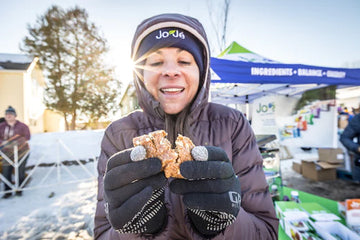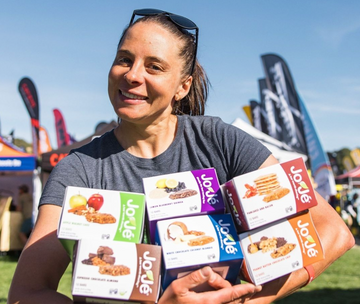
Enjoy this guest post from JoJé athlete Michaela Keller-Miller

Every winter in late February, cross country skiers converge on a small Wisconsin town for the largest ski race in North America: The American Birkebeiner, more commonly called the Birkie. New and elite skiers alike race 50 kilometers from Cable, Wisconsin to finish down the main street of Hayward, Wisconsin.
Growing up in Minnesota, I’d experienced firsthand the “Birkie fever” that sweeps through the Midwest ski community every winter as skiers prepare for the pinnacle event of the season. But despite my Midwest roots, I’d never actually raced the Birkie, instead following the mystique from afar for the past five years. This year, I finally made the migration home to see what the Birkie hype was all about. I currently ski for the Craftsbury Green Racing Project, a professional ski team based out of the Craftsbury Outdoor Center in Vermont, and raced all winter on the US SuperTour circuit, the top level of domestic racing for American cross country skiers. Luckily for me, the Birkie happened to be one of the races on the SuperTour circuit this past ski season.
The Demands of Cross-Country Skiing
Cross-country skiing is unique in that most skiers don’t specialize in a certain distance, rather racing every event from a 1.5-kilometer “sprint” up to 50-kilometer races like the Birkie. Since elite skiers train to handle all race distances, most typically train high volume (between 650-1,000 hours per year) and add in intensity training to have both the stamina for long races and the speed for shorter races.
When preparing for this year’s Birkie, I enjoyed a mix of long 3+ hour skis, as well as threshold intervals. No matter the workout, I’ve found it especially important to be intentional about proper hydration and fueling, as this is also a key component to keeping energy levels stable throughout marathon races.

How to Fuel for Cross-Country Skiing
When training for multiple hours, I like to carry both JoJé Bars and SaltStick Caps or FastChews in my water pack to avoid crashing energy levels or “bonking.” My current personal favorites are JoJé’s Espresso Chocolate Almond bars and SaltStick’s peach-flavored FastChews. Making the effort to eat even a few bites of a bar every hour does wonders for staying ahead of and avoiding a bonk, rather than waiting to eat until after an energy crash.
Properly hydrating with electrolytes is equally important as eating throughout long-distance workouts and can help to avoid feeling dehydrated for hours following a workout. I’ve been particularly impressed with the effectiveness of both SaltStick’s Caps and FastChews, as they were specially formulated to contain the specific quantities of electrolytes that the body loses through sweat.
FastChews are chewable tablets that make it especially easy to ensure I’m absorbing the right nutrition to keep my performance up. Since declines in performance often occur in the second half of long-distance races like the Birkie, having a nutrition plan that includes electrolytes from the beginning is critical to staying as fresh as possible throughout.
QUICK FUELING TIP: Consuming water and electrolytes as often as every 30 minutes is a good starting point for hydration during both marathon races and long workouts.
My First Birkie Experience
As this was my first Birkie, I made the rookie move of forgetting to drink (and eat) early and often and paid the price. The beginning of marathon races oftentimes feels controlled, making it all too easy to hold off on fuel until it’s too late. After eating a breakfast of oatmeal loaded with plenty of toppings, I made sure to consume part of a JoJé bar 30 minutes prior to the start. Once the race began, I settled in with the lead pack, focusing on skiing relaxed and relegating my nutrition plan to the back of my brain.

By the halfway point, I realized that I had only managed to consume limited electrolytes and a partial bottle of water, completely failing to consume any solid food or liquid calories. This became increasingly evident as I crossed the sign marking 23 kilometers to go and felt my legs beginning to seize up. Pushing this feeling out of my mind, I tried to maintain contact with the pack I was with, only for the seizing feeling in my legs to grow stronger with each ensuing climb. In an attempt to reverse the beginnings of a major bonk, I consumed additional water and FastChews, but realized I had waited too long.
Crossing the Finish Line
Throughout the final 20 kilometers, my goal changed from a strong result to just crossing the finish line. As I continued at what felt like a crawl, I was solely focused on placing one foot ahead of the other as the kilometer markers slowly ticked by. There were times during these last kilometers when I doubted that I could physically make it to Main Street, making it even sweeter when I finally skied across the line. Arguably more satisfying were the warm JoJé bars at the finish, which I credit to my quick recovery from the most epic bonk I’d ever experienced during a ski race.
Lessons Learned About Nutrition + Hydration
There are many different nutrition strategies for marathon-length races, but I’ve learned that setting a plan (and sticking to it) is incredibly important.
QUICK FUELING TIP: Since the Birkie, I’ve tested fueling methods and found that consuming solid food like JoJé bars over liquid calories helps me to avoid crashing energy levels. Not only this, but consuming electrolytes every 30 minutes and possibly more frequently in the early stages of a race is critical in preventing cramping.
SaltStick’s range of electrolytes, from liquid Elixalyte to FastChews and Caps, provides ample hydration options to choose from.
Despite learning hard lessons on fueling, it was a dream to finally live up to my Midwest roots and race the Birkie. I grew up cheering on my ski idols as they skied down the main street of Hayward, using their last bits of energy to sprint the homestretch across the finish line. Thousands of fans’ cheers mingle with cowbells as skiers accomplish their goal of completing 50 hilly and challenging kilometers.
Some have just learned to ski months prior, and some have been skiing since they could walk, but everyone on that main street at the end of February experiences firsthand the infectious energy of the North American ski community.
Birkie fever runs high throughout the crowds and wanes come summer, but it will undoubtedly return when the flakes begin to fall the following ski season.






